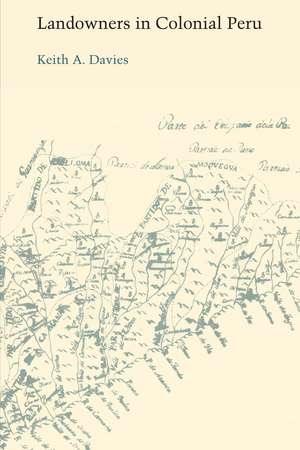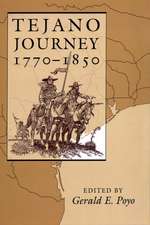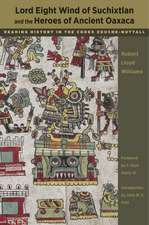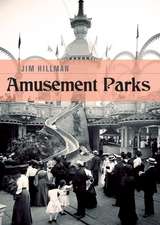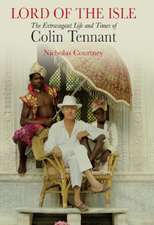Landowners in Colonial Peru: LLILAS Latin American Monograph Series
Autor Keith A. Daviesen Limba Engleză Paperback – dec 1984
Arequipa’s case suggests another fundamental cause of capitalist behavior in colonial South America: rural wealth was inextricably tied to the colonists’ desire to reinforce and improve their stature. Arequipa’s Spanish families of the upper and middle social levels consistently employed land and its proceeds to attract prominent spouses, to acquire prestigious political and military posts, and to enhance their standing by becoming benefactors of the Church. They rarely lost sight of the crucial role that wealth played in their lives. Thus, when the region’s economy flourished, as it did during the late 1500s, they expanded and improved their holdings. When it faltered at the beginning of the next century, they made every effort to retain properties, even fragmenting land to accommodate family members and new spouses. Unlike patterns sometimes suggested for Spanish America, many Arequipan colonial families possessed land and retained it over many generations. Neither the increasingly rich Church nor a few powerful persons managed to build up extensive estates.
Landowners in Colonial Peru explains how and why rural property became so important. It emphasizes both the capitalist bent of Hispanics and the manner in which wealth served social aspirations. The approach makes clear that many of the economic and social characteristics so often attributed to eighteenth- and nineteenth-century Latin Americans were present from the early Colonial period.
Din seria LLILAS Latin American Monograph Series
-
 Preț: 123.28 lei
Preț: 123.28 lei -
 Preț: 197.60 lei
Preț: 197.60 lei -
 Preț: 158.95 lei
Preț: 158.95 lei -
 Preț: 224.14 lei
Preț: 224.14 lei -
 Preț: 199.89 lei
Preț: 199.89 lei -
 Preț: 263.34 lei
Preț: 263.34 lei -
 Preț: 160.09 lei
Preț: 160.09 lei -
 Preț: 198.73 lei
Preț: 198.73 lei -
 Preț: 240.63 lei
Preț: 240.63 lei -
 Preț: 200.06 lei
Preț: 200.06 lei -
 Preț: 203.36 lei
Preț: 203.36 lei -
 Preț: 199.89 lei
Preț: 199.89 lei -
 Preț: 198.90 lei
Preț: 198.90 lei -
 Preț: 198.90 lei
Preț: 198.90 lei -
 Preț: 305.21 lei
Preț: 305.21 lei -
 Preț: 200.66 lei
Preț: 200.66 lei -
 Preț: 280.43 lei
Preț: 280.43 lei -
 Preț: 203.36 lei
Preț: 203.36 lei -
 Preț: 203.73 lei
Preț: 203.73 lei -
 Preț: 198.90 lei
Preț: 198.90 lei -
 Preț: 158.36 lei
Preț: 158.36 lei -
 Preț: 200.28 lei
Preț: 200.28 lei -
 Preț: 232.08 lei
Preț: 232.08 lei -
 Preț: 160.48 lei
Preț: 160.48 lei -
 Preț: 225.50 lei
Preț: 225.50 lei -
 Preț: 158.75 lei
Preț: 158.75 lei -
 Preț: 199.51 lei
Preț: 199.51 lei -
 Preț: 240.26 lei
Preț: 240.26 lei -
 Preț: 282.17 lei
Preț: 282.17 lei -
 Preț: 280.59 lei
Preț: 280.59 lei -
 Preț: 277.16 lei
Preț: 277.16 lei -
 Preț: 200.66 lei
Preț: 200.66 lei -
 Preț: 198.90 lei
Preț: 198.90 lei -
 Preț: 375.00 lei
Preț: 375.00 lei -
 Preț: 239.87 lei
Preț: 239.87 lei -
 Preț: 203.36 lei
Preț: 203.36 lei -
 Preț: 232.88 lei
Preț: 232.88 lei -
 Preț: 159.51 lei
Preț: 159.51 lei -
 Preț: 231.70 lei
Preț: 231.70 lei -
 Preț: 199.89 lei
Preț: 199.89 lei -
 Preț: 241.02 lei
Preț: 241.02 lei -
 Preț: 200.26 lei
Preț: 200.26 lei -
 Preț: 263.93 lei
Preț: 263.93 lei -
 Preț: 158.20 lei
Preț: 158.20 lei -
 Preț: 223.56 lei
Preț: 223.56 lei -
 Preț: 203.73 lei
Preț: 203.73 lei -
 Preț: 160.27 lei
Preț: 160.27 lei -
 Preț: 225.50 lei
Preț: 225.50 lei -
 Preț: 241.38 lei
Preț: 241.38 lei -
 Preț: 299.28 lei
Preț: 299.28 lei
Preț: 198.89 lei
Nou
Puncte Express: 298
Preț estimativ în valută:
38.06€ • 41.47$ • 32.07£
38.06€ • 41.47$ • 32.07£
Carte tipărită la comandă
Livrare economică 23 aprilie-07 mai
Preluare comenzi: 021 569.72.76
Specificații
ISBN-13: 9780292766211
ISBN-10: 0292766211
Pagini: 248
Dimensiuni: 152 x 229 x 20 mm
Greutate: 0.34 kg
Editura: University of Texas Press
Colecția University of Texas Press
Seria LLILAS Latin American Monograph Series
ISBN-10: 0292766211
Pagini: 248
Dimensiuni: 152 x 229 x 20 mm
Greutate: 0.34 kg
Editura: University of Texas Press
Colecția University of Texas Press
Seria LLILAS Latin American Monograph Series
Notă biografică
Keith A. Davies received his Ph.D. in history from the University of Connecticut in 1974.
Cuprins
- Preface
- Introduction
- 1. Indians, Encomenderos, and Arequipa’s Early Rural Economy
- 2. Chácaras and Estancias in Early Arequipa
- 3. Wine Estates and Landowners
- 4. Encomenderos, Landowners, and Society in Sixteenth-Century Arequipa
- 5. The Wine Economy
- 6. Colonial Expansion into the Indian Southwest
- 7. Land and Society in Seventeenth-Century Arequipa
- Conclusion
- Appendix A: Francisco Pizarro’s Indian Grants in Southwestern Peru
- Appendix B: Mercedarian Assessments on Landowners in Vítor Valley for Pastoral Care, 1583
- Appendix C: Archbishop’s Assessments on Landowners in Vítor Valley for Pastoral Care, ca. 1660
- Notes
- Glossary
- Index
Descriere
The first study to examine the agrarian history of a region in South America from the mid-sixteenth through late-seventeenth century.
